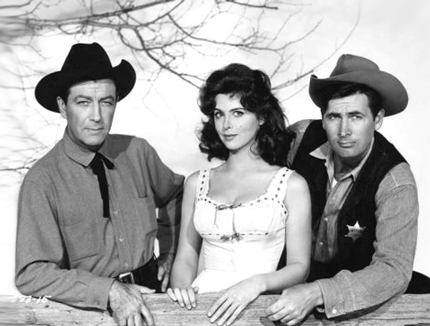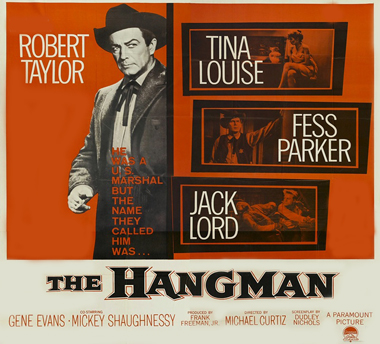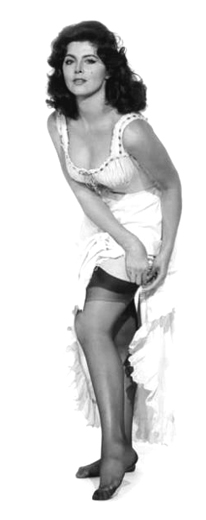
 |
|
|
|
Paramount's The Hangman is a good example of a film made during the decline of the studio system, when the factory system was breaking down and the movie-a-week habit was disappearing as well. To be a real success in 1959 a picture needed to be a one-of-a-kind attraction with something unique to market to the public. Previously, movies from the assembly line system were special because most of Hollywood's major talent, even the biggest stars were studio contractees, along with the best writers and technical artists. This show uses Robert Taylor, now a free agent after recently being one of the last Golden Age stars let go by MGM. Director Michael Curtiz was near the end of his impressive career. Of the top cast, the only relative newcomers were Tina Louise and Jack Lord. Filmed in B&W on the standing Paramount Western street set, The Hangman lacks pictorial values that might distinguish it from the scores of westerns then on Television. 
Veteran screenwriter Dudley Nichols had been working in Hollywood for almost thirty years, and this is one of his last pictures. He opts for an uncomplicated crime drama that could easily be adapted to almost any setting. The movie has no major action scenes. The one time the hero fires his gun, he purposely misses. Deputy Federal Marshall Mack Bovard (Robert Taylor) so ruthlessly hunts down wanted killers that he's been given the nickname, "The Hangman". Mack wants to arrest the fourth fugitive from a deadly bank robbery committed a couple of years ago, but nobody knows what he looks like. He finds his quarry in a small town, hiding out as Johnny Bishop (Jack Lord). The only person who can identify Johnny is laundress Selah Jennison (Tina Louise), a young widow who cannot afford to turn down Bovard's $500 reward for turning Judas. To his surprise, Mack finds that Johnny Bishop has the trust and faith of all his neighbors and friends, none of whom believe he could have been part of a crime. Johnny's new wife is expecting a child. This includes Sheriff Buck Weston (Fess Parker) and Bishop's fellow teamster Al Cruse (Mickey Shaughnessy). The thuggish Big Murph (Gene Evans) may be willing to sell Bishop out, but even he believes the man to be innocent. Selah and Sheriff Weston challenge Mack's assertion that every man has his price, and that nobody can be trusted, but the Marshall remains unmoved. Selah purposely fails to identify Johnny, even though she'll lose her reward. The anti-law conspiracy among the townspeople only makes Mack Bovard more determined to bring Johnny Bishop to Justice. 
The Hangman takes its interesting premise to an unsurprising conclusion, without reaching the dramatic climaxes it needs to properly resolve its personal tensions. Robert Taylor's Mack Bovard spends the entire movie spouting a cynical attitude about human nature, convinced that everyone he meets is a dishonest liar willing to sell out for money. When Selah doesn't show up for duty, Mack thinks she's different and makes plans to go back to her. But then she turns up to play informer for money. It's exactly what Bovard wants her to do, and what he says is the right thing to do. Yet he now turns more resentful than ever. The problem with The Hangman is that not a great deal seems to happen. Bovard and the easy-going sheriff continue to trade philosophies long after their opposition has established. The details of Bovard's mission seem kind of silly. He instructs Selah to arrive in town on a different stagecoach, so they won't be associated with each other. He then hangs out almost exclusively with the Sheriff, and tells the hotelier outright that he's reserving a room for Selah. This is a small town: the relationship of Bovard to Selah and his mission would be common knowledge in just a few hours. Selah wouldn't need to take a secret message to Johnny Bishop. As this is really just the story of a cop who ultimately decides he's being too harsh, The Hangman could easily be shifted to a different background, say, a juvenile delinquent story. The few scenes with Jack Lord and Tina Louise are the most interesting. Johnny and Selah may have been lovers, briefly, but the script curiously doesn't go into that. Johnny is an innocent victim of the real robbers, something Mack Bovard might appreciate if approached in the right way. Unfortunately, Selah and Bovard are so continually at odds with each other -- she even handcuffs herself to him at one point, to interfere with his duties -- that we know they will eventually get together. I mean, Fess Parker is nice, if you want someone to play guitar or sell you some wine. Robert Taylor is 23 years older than Tina Louise, but he's still more attractive. 
Ms. Louise always had acting ability and her role here is better than many she was offered at this stage of her career. The Hangman makes sure that she's seen in one glamorous dress, complete with a frilled parasol. It actually makes her rather overdressed for this two-bit town. Apparently deciding that the sex factor needed to be turned up a few notches, we also have Marshall Bovard wandering into her room while she's getting dressed, so that Ms. Louise can show off her legs, etc. Selah owns some of the most shapely, form-fitting undergarments seen in a western movie. By this time a western couldn't be a western without at least one bathtub scene or skinny dipping romp in the local pond, and The Hangman has one of each. Scenes like this, substituting coded peek-a-boo thrills for actual adult relationships, are what made Hollywood movies look infantile when compared to the best foreign dramas. The secondary characters are around for atmosphere and an occasional distraction. Mickey Shaughnessy and Gene Evans are dependable as a good egg and a knave, respectively. Usually positioned as a token harmless Mexican, Pedro Gonzales Gonzales here plays an excitable little jerk that tries to kill Bovard with both a pistol and a shotgun. Mabel Anderson is comic relief as an old fool who sets her cap for Robert Taylor (heck, give the lady a break, Bob). A sweet waitress who gets our attention is Betty Lynn, later of The Andy Griffith Show. Lorne Greene has fifteen seconds on screen as another lawman. This uncredited role may have been a special favor to someone, for Greene was launched as the star of his big TV series Bonanza the very same year. Olive Films' Blu-ray of The Hangman is a handsome encoding of this widescreen B&W picture. Loyal Griggs' cinematography is acceptable but never particularly attractive. The added resolution does make Ms. Louise look more beautiful than ever. There's an axiom about Hollywood's leading ladies in this highly competitive era -- if they look this good on screen, chances are that in person they are too gorgeous to be believed. The transfer is fairly clean with a few marks on the title sequence. But the last reel or so is lightly dusted with many tiny white specks that are easy to ignore yet there just the same. I only mention them in the interest of full disclosure.
On a scale of Excellent, Good, Fair, and Poor,
The Hangman Blu-ray rates:
Reviews on the Savant main site have additional credits information and are often updated and annotated with reader input and graphics. Also, don't forget the 2011 Savant Wish List. T'was Ever Thus.
Review Staff | About DVD Talk | Newsletter Subscribe | Join DVD Talk Forum |
| ||||||||||||||||||